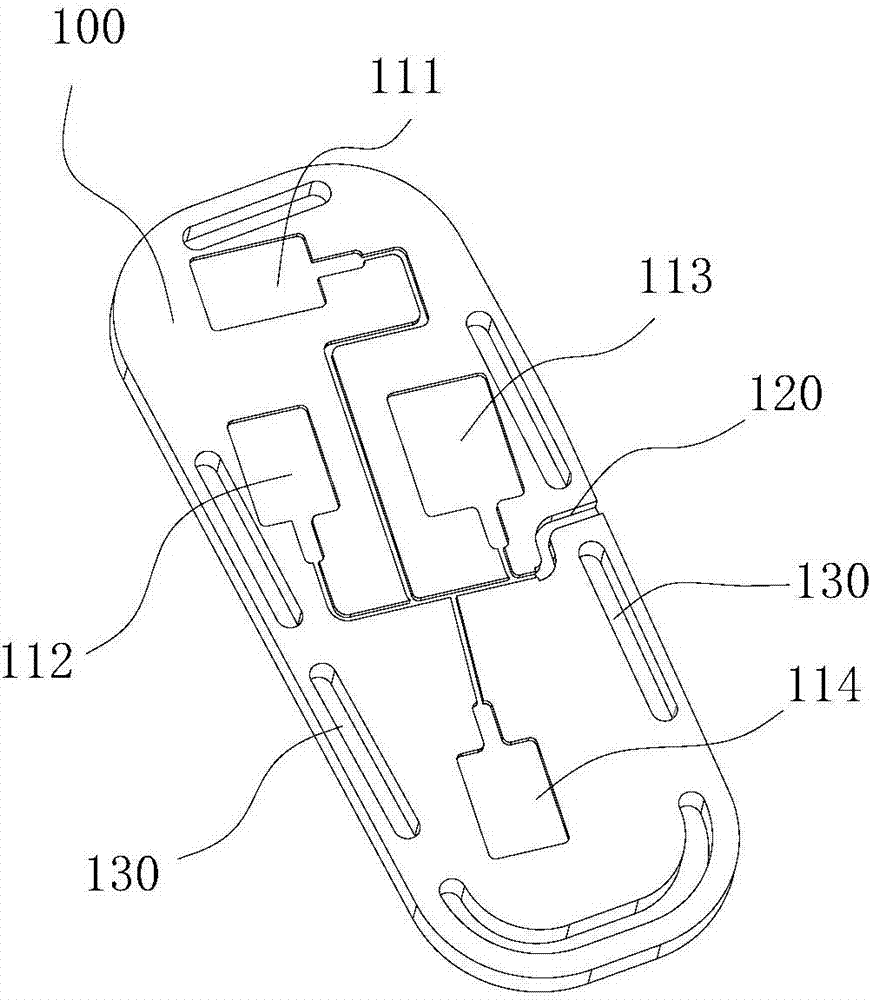Gait recognition method and device
A gait recognition and gait technology, applied in character and pattern recognition, instruments, computer parts, etc., can solve the problems that the accuracy needs to be improved
- Summary
- Abstract
- Description
- Claims
- Application Information
AI Technical Summary
Problems solved by technology
Method used
Image
Examples
Embodiment 1
[0084] The first embodiment provides a plantar pressure detection mechanism, which can collect pressure signals of various parts of the human foot. The control system can use the pressure signal collected by the mechanism for subsequent processing, such as judging the movement of the human foot, so as to control the actuator to perform corresponding actions.
[0085] Please refer to figure 1 , the plantar pressure detection mechanism includes:
[0086] support layer 100;
[0087] A pressure sensor (the pressure sensor is a conventional choice, not shown in the figure), the pressure sensor is installed on the support layer 100;
[0088] And the cover layer 200 for being arranged on the sole of the human body, the cover layer 200 includes the toe area A for spreading the pressure applied to the toe part of the human body, and the arch area A for spreading the pressure applied to the arch part of the human body B and the heel area C for spreading the pressure exerted on the he...
Embodiment 2
[0107] The second embodiment provides a gait recognition method, which is used to recognize the gait of a human body, and then output a corresponding command to the actuator, so that the actuator can cooperate with the gait of the human body.
[0108] Please refer to Figure 4 , the gait recognition method includes:
[0109] Definition step: define the pressure state corresponding to the toe position, the arch position and the heel position of the sole under each gait phase, and the pressure state is divided into a high pressure state and a low pressure state;
[0110] Signal acquisition step: Acquire the pressure detection signals of the toes, arches, and heels at the same time;
[0111] Converting step: converting the obtained pressure detection signal into a digital signal representing a high pressure state or a low pressure state;
[0112] Judgment step: compare the acquired pressure states of the toes, arches, and heels with the pressure states defined by each gait phas...
Embodiment 3
[0162] Embodiment 3 provides a gait recognition device corresponding to Embodiment 2, including:
[0163] The definition module is used to define the pressure state corresponding to the toe position, the arch position and the heel position of the sole under each gait phase, and the pressure state is divided into a high pressure state and a low pressure state;
[0164] The signal acquisition module is used to acquire the pressure detection signals of the toes, arches and heels of the soles of the feet at the same time;
[0165] A conversion module, configured to convert the obtained pressure detection signal into a digital signal representing a high pressure state or a low pressure state;
[0166] The judging module compares the pressure state of the toe, arch, and heel with the pressure state defined in each gait phase at the same time. If it is consistent with the result of a certain gait phase, it is judged that the current state Gait phase; if it is different from all gait...
PUM
 Login to View More
Login to View More Abstract
Description
Claims
Application Information
 Login to View More
Login to View More - R&D
- Intellectual Property
- Life Sciences
- Materials
- Tech Scout
- Unparalleled Data Quality
- Higher Quality Content
- 60% Fewer Hallucinations
Browse by: Latest US Patents, China's latest patents, Technical Efficacy Thesaurus, Application Domain, Technology Topic, Popular Technical Reports.
© 2025 PatSnap. All rights reserved.Legal|Privacy policy|Modern Slavery Act Transparency Statement|Sitemap|About US| Contact US: help@patsnap.com



